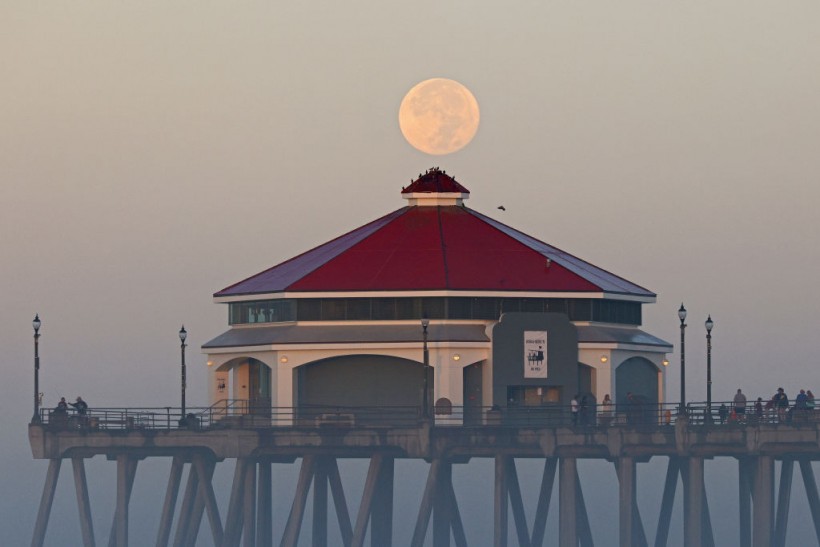The Sturgeon Supermoon, a name for August's full moon, will reach its peak brightness on Tuesday, August 1. According to Live Science, this is the second supermoon of the year, following July's Buck Moon, and it will be nearly as large as the most prominent supermoon of 2023, set to appear on August 30.
Notably, the Sturgeon Supermoon is the first of two full moons in August, which makes the August 30 full moon a relatively uncommon Blue Moon occurrence.

The Sturgeon Moon sets behind the Huntington Beach Pier over the Pacific Ocean on August 12, 2022 in Huntington Beach, California.
When To See This Year's Sturgeon Moon?
August's full moon will be at its fullest on Tuesday, August 1, 2023, at 1:33 p.m. EDT, as per timeanddate.com. It will also appear bright and full on July 31 and August 2. The name "Sturgeon Moon" originates from North America's abundant sturgeon fish family found in the Great Lakes during this time of year. The Anishinaabeg people refer to it as Minoomini Giizis or the Grain (Wild Rice) Moon.
The Sturgeon Moon will be best observed rising in the east during the evening from North America, with over 99% illumination. It will be around 222,023 miles (357,311 kilometers) from Earth's center at its peak, making it the second-largest supermoon of 2023.
Moreover, Space.com reported that the full moon on August 1 will have different rising times depending on the observer's location. On the U.S. eastern seaboard, the moon sets at 5:12 a.m., Eastern Time and rises at 8:43 p.m., local time in New York City.
The full moon occurs when the moon is directly opposite the sun from the perspective of Earth. Thus, the exact hour of the full moon varies by time zone: 11:32 a.m. in Los Angeles, 7:32 p.m. in London, and 8:32 p.m. in Paris.
In these cities the moon becomes full before it rises above the horizon. To witness the moon rise before reaching full phase, one must go as far east as Athens, Greece.
Moonrise times are influenced by latitude and time zone. Locations further north will experience later moonrises, while areas below the equator will have earlier moonrise times. Even within the same time zone, there can be differences in moonrise times due to variations in longitude.
READ ALSO: New Moon Tonight Will be Closest to Earth Ever Since Year 1030
When Do Supermoons Appear?
Supermoons happen when the full moon aligns with its perigee, which is the closest point to Earth in its orbit. The average distance for perigee and apogee can vary, spanning from 225,800 to 251,800 miles (363,400 to 405,500 km), respectively.
To qualify as a supermoon, a full moon must come within 90% of its perigee. Astronomer Fred Espenak told Live Science that the term "supermoon" is used for a perigean full moon, which happens when the moon is closest to Earth during its orbit.
The Farmer's Almanac reported that there are four consecutive supermoons this year with the August 1 full moon being the second in this extraordinary sequence.
Supermoons appear up to 8% larger in disk size and about 16% brighter compared to an average-sized full moon. While the difference in size may not be easily perceived by the naked eye, supermoons do appear noticeably brighter in the night sky.
RELATED ARTICLE: Sturgeon Supermoon 2022 Amazes Residents in the Europe and the Middle East [See Photos]
Check out more news and information on the Moon in Science Times














